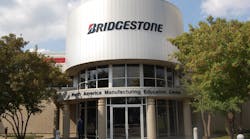NASHVILLE, TN. A renewed effort is underway at Bridgestone Commercial Solutions (BCS) to get motor carriers large and small to view their tires as long-term “assets” – much like tractors, trailers, and other trucking-related equipment – rather than as commodities to be compared merely on purchase price.
During an all-day event that included a tour of Bridgestone’s nearly 2 million square foot truck tire plant in Warren County, TN, and its North American Manufacturing Education Center attached to its LaVergne Firestone truck tire facility, BCS executives explained that using “life cycle costing” strategies remains the best way to ensure fleets achieve a return on dollars invested in tires.
“It’s about focusing on a total solution when it comes to tires, not just the purchase price,” noted Kurt Danielson, president of BCS. “It’s easy to make a cheap tire and get it out there. What’s not easy is ensure that tires help improve the fuel economy of tractor-trailers, that they help keep trucks up and running. It’s that additional value that helps fleets be profitable and successful.”
That’s one of the reasons Bridgestone developed its Ecopia line of fuel efficient truck tires – unveiled last March at the Mid America Trucking Show – and made changes to its complimentary line of FuelTech fuel efficient retread materials, explained Scott Damon, VP-marketing for BCS.
“It’s all about adding more value to the end user,” he said. “Ecopia is a tire designed to combine low rolling resistance with optimal wear characteristics, all without sacrificing characteristics such as traction and braking performance.”
Ecopia is also a tire line designed to be retreaded multiple times if maintained properly – further lowering tire life cycle costs for a fleet.
“A retread costs only 35% to 45% of what a new tire costs, so the longer a tire casing can be used, the more its ‘cost per mile’ declines,” noted Guy Walenga, director of engineering for Bridgestone Americas Tire Operations (BATO).
Part of that costs savings comes from using less oil, as it takes 22 gallons of oil in the construction of a new tire, versus just seven gallons when it comes to a retread, Damon pointed out.
Improving the low rolling resistance characteristics of truck and trailer tires – both when new and as retreads – further improves those cost per mile metrics, Walenga stressed, as a 5% improvement in rolling resistance equates to a 1% gain in fuel economy.
“If you maintain proper tire air pressure, you’ll get the best rolling resistance and thus the best fuel savings – as well as help preserve the tire casing for re-use,” he added. “That ensures that fleets don’t leave money on the table when it comes to tire management.”
It’s really thinking about not just the tire itself but what wraps around it, especially when it comes to retreading, explained Danielson.
“Buying just a ‘good tire’ is not longer good enough anymore,” he stressed. “As we went through the ‘Great Recession,’ a lot of trucking companies survived by tightening up on their business. That’s why we believe the key to maximizing tire value going forward is to view them as assets and not commodities.”
“Tires are getting more expensive due to the higher cost of raw materials; that’s why fleet’s need to measure total cost, not just purchase price,” Damon added. “The challenge in a market that’s become more focused on price is to show greater value, in that a new tire that can be retreaded several times while offering better fuel economy offers a lower total cost than a tire with cheaper purchase price that can’t be retreaded.”



